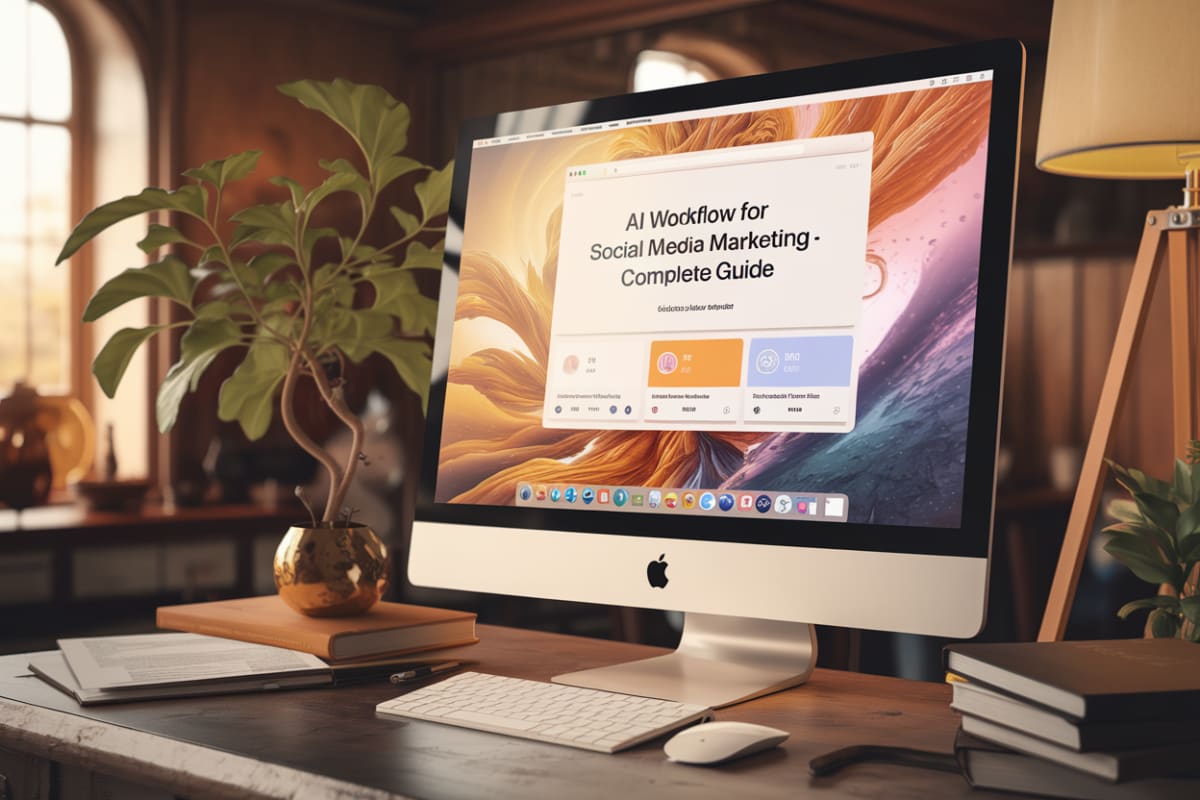Social Media Checklist 2025
Key Elements of a Social Media Checklist for 2025
Embrace AI and Automation
- Explore AI Tools: Utilize AI tools across platforms, such as Meta's content suggestions and LinkedIn's collaborative articles. Streamline content creation and enhance audience engagement. For example, Enrich Labs' AI Social Media Coordinator autonomously moderates and analyzes thousands of comments and DMs across all major platforms, custom-trained on your brand voice—allowing you to focus on higher-impact work. Many teams experience a significant reduction in response times and improved engagement rates.
Focus on Social Commerce
- Integrate Shopping Features: With the rise of social commerce on platforms like TikTok Shop, ensure your social strategy includes seamless purchasing experiences integrated into your content. Brands should leverage these features to drive sales directly through social media.
Authentic and Relatable Content
- Shift Towards Genuine Content: Prioritize storytelling and authentic content over polished advertisements. Brands should aim for real connections with their audiences by sharing relatable stories and user-generated content (UGC), enhancing trust and engagement.
Short-form Video Content
- Prioritize Video Formats: As short-form videos continue to dominate platforms like TikTok and Instagram Reels, develop a strategy for creating engaging, bite-sized video content.
Community Engagement Strategies
- Cultivate Smaller Communities: Focus on building intimate, engaged communities rather than just broad audiences. Utilize platforms like Discord for niche groups, encouraging real-time interactions and feedback.
Regular Measurement and Analytics
- Track Performance Metrics: Establish a robust measurement framework using social media analytics tools to track performance against business goals. Key metrics include engagement rates, reach, and conversion metrics, which help in refining strategies and demonstrating ROI.
Content Calendar Planning
- Annual Content Calendar: Develop a comprehensive social media calendar that includes key dates, holidays, and audience engagement opportunities. Map out content themes for the year to ensure consistent and relevant posting.
Repurpose High-Performing Content
- Repost Evergreen Content: Identify and repurpose high-performing posts from the previous year, as many followers may not have seen them. This maximizes reach and saves time in content creation.
Engage with Trends and Memes
- Utilize Current Trends: Stay updated with trending topics and memes to keep content fresh and relatable. Engaging with popular culture can significantly increase visibility and engagement.
Training and Development
- Invest in Team Training: Regularly train your social media team on emerging trends, tools, and best practices to ensure they remain competitive and effective in their roles.
By incorporating these elements into your 2025 social media checklist, you enhance engagement, drive business impact, and stay ahead in the rapidly evolving social media landscape.
Optimize Your Social Media Strategy for 2025
Embrace AI Tools: To stay competitive, integrate AI into your social media strategy. Platforms like Meta and LinkedIn leverage AI for content creation and customer interaction. Use Enrich Labs' AI Social Media Coordinator for efficient moderation and insightful analysis—helping your team manage high volumes of interactions without sacrificing brand voice or response times.
Focus on Performance Marketing: Shift metrics from vanity metrics (likes and shares) to measurable business outcomes. Tools for social listening and analytics connect social media efforts to ROI, enhancing the perceived value of social media within your organization.
Experiment with Content: Explore creative content formats that diverge from your brand's traditional voice. Brands like Nutter Butter created engaging narratives that resonated with audiences, fostering a stronger emotional connection.
Engage with Influencers and Communities: Democratize your influencer strategy by involving top customers alongside influencers in campaigns. This enhances authenticity and drives engagement, as seen with brands like Waterboy.
Leverage Decentralized Platforms: Users gravitate towards platforms like Reddit and Bluesky for authentic interactions. Establish a presence in these communities to foster deeper connections.
Prioritize Authentic Content: As consumers become more skeptical, prioritize genuine, well-crafted content over polished advertisements. Brands that engage with customer feedback, including negative reviews, often enhance their authenticity.
Plan for Short and Long-Form Content: With the growing popularity of short-form video content and the resurgence of long-form content, diversify your strategy to cater to different audience preferences.
Create Real-Life Engagement Opportunities: Incorporate in-person events such as pop-ups or exhibitions to enhance community building. Brands like Ulta connect with audiences and increase visibility through influencer-generated content at events.
By aligning your strategy with these trends, you effectively optimize your social media presence for 2025 and beyond.
Latest Social Media Trends for 2025
Creators and Brands Will Focus on World-Building: Experts predict a shift towards immersive ecosystems where creators and brands develop interconnected content. An example is The Washington Post's serialized storytelling on TikTok.
Rise of Smaller Communities: There is a growing trend towards smaller, exclusive spaces for interaction, with features like Instagram Broadcast Channels facilitating intimate creator-audience connections.
Increased Use of AI in Content Creation: AI will play a significant role, with tools integrated into platforms for content creation and customer service.
Social Commerce Expansion: Social commerce, particularly through TikTok Shop, is expected to rise, merging entertainment with seamless purchasing experiences.
Emphasis on Authentic Content: Brands will prioritize genuine content over polished advertisements to build trust with skeptical consumers.
Growth of Micro and Nano-Influencers: Collaborations with micro and nano-influencers will become the norm for brands seeking authenticity.
Long-Form Content Gains Popularity: Long-form content, especially episodic series on YouTube, is expected to draw viewers seeking in-depth narratives.
Decentralized Social Networks: With a focus on user privacy, decentralized platforms like Mastodon are likely to gain traction.
Adoption of User-Generated Content (UGC): Brands will rely more on UGC to foster community engagement and authenticity.
Mental Health Focus: As awareness around mental health grows, social media platforms will see an influx of content dedicated to mental wellness.
Virtual Influencers and AI-Generated Content: The rise of virtual influencers and AI-generated content will reshape influencer marketing strategies.
Enhanced Analytics and Social Listening: Social media marketing will become more data-driven, with advanced analytics tools allowing marketers to measure ROI effectively.
Long-Term Partnerships with Influencers: Brands will seek long-term collaborations with influencers, moving away from one-off campaigns.
These trends reflect a shift towards more personalized, engaging, and community-driven social media strategies as brands adapt to the evolving digital landscape.
For further details, refer to sources like Buffer and Marketing Monk.
Posting Frequency Overview for 2025
There is no one-size-fits-all answer for social media posting frequency in 2025. It largely depends on content quality, audience engagement patterns, and specific business objectives. Research suggests the following optimal posting frequencies across various platforms:
Instagram: Aim for 3-7 feed posts per week and 4-7 Stories per day. Brands that post consistently within this range see significantly higher engagement rates, with those posting 3-7 times a week experiencing 2.5x more engagement than less frequent posters Popular Pays.
TikTok: Posting 1-3 videos daily is recommended; some successful accounts post as many as 4 times a day to maintain visibility LouiseM.
LinkedIn: Posting 2-5 times per week is ideal, generating 3x more engagement than erratic posting schedules Popular Pays.
Facebook: The optimal frequency is once per day, with a maximum of two posts per day. Pages with fewer than 10,000 fans should avoid posting more than once daily to prevent a drop in engagement LouiseM.
Twitter/X: Brands should tweet 2-5 times a day, as higher frequency leads to better engagement Popular Pays.
Pinterest: Posting 3-7 times per day can help maintain visibility, especially for brands leveraging this platform effectively Popular Pays.
Quality vs. Quantity
Focus on delivering high-quality, engaging content rather than just meeting a numerical target. According to industry insights, 72% of consumers prefer fewer, higher-quality posts over frequent, lower-quality content.
Key Considerations
Audience Engagement Patterns: Analyze when your audience is most active on each platform to optimize posting times. Tools like social media analytics provide insights into peak engagement times.
Content Strategy: Develop a content calendar that aligns with your business objectives and audience preferences, ensuring a sustainable and manageable posting schedule.
Resource Capacity: Determine your capability in content creation. Brands should only post as often as they can maintain quality; a small business may start with 2-3 posts per week and scale up as engagement grows LouiseM.
Essential Metrics to Track in 2025
Engagement Metrics: Understand how your audience interacts with your content. This includes likes, comments, shares, and saves.
- Likes and Comments: High numbers indicate content resonates with the audience. For example, a campaign generating 2,000 likes and 300 comments suggests strong engagement.
- Shares: Content shared often indicates high value. Posts with over 500 shares can significantly increase brand visibility.
Reach and Impressions: These metrics measure how many people see your content and how often.
- Reach: The total number of unique users seeing your content. A post reaching 10,000 unique users indicates good exposure.
- Impressions: The total number of times your content displays, regardless of clicks. A post with 50,000 impressions but low engagement may require content reevaluation.
Follower Growth Rate: The rate at which your follower base increases measures brand popularity and engagement effectiveness. A 10% increase in followers over a quarter can indicate successful content strategies.
Conversion Rates: This tracks how many interactions lead to desired actions, such as sales or newsletter sign-ups. A 5% conversion rate from social media traffic indicates effective targeting and engagement.
Video Metrics: Given the importance of video content:
- Video Views: Indicates how many times your video content has been viewed.
- Video Completion Rates: The percentage of viewers watching your video to the end. High completion rates (above 70%) suggest compelling content.
Customer Sentiment: Tracking audience feelings about your brand through comments and reviews provides insights into public perception. Positive sentiment in 80% of comments can enhance brand reputation.
Response Rates and Times: As social media becomes a key customer service channel, tracking response times to queries is vital. A 90% response rate within an hour can enhance brand loyalty.
Share of Voice: This metric measures your brand's presence compared to competitors. Monitoring share of voice can help identify market position and brand health.
Website Traffic from Social Media: Tracking visitors coming to your website from social media helps assess campaign effectiveness. For example, 1,000 visits from a single campaign indicate significant interest.
Strategies for Improving Social Media Engagement in 2025
Utilize Advanced AI Tools: Leverage artificial intelligence for content creation and audience analysis. Enrich Labs' AI Social Media Coordinator stands out as a top choice—automating tedious tasks and providing actionable insights that enhance engagement. Brands using AI tools often report improved response times and increased audience interactions.
Focus on Short-Form Video Content: Platforms like TikTok and Instagram Reels dominate engagement. Creating authentic, relatable short videos can dramatically improve engagement. A small business showcasing behind-the-scenes processes through Reels saw a 50% increase in comments and shares.
Interactive Content: Polls, quizzes, and interactive stories engage users effectively. A fashion retailer regularly posting quizzes about style choices experienced a 40% higher interaction rate than static posts.
Community Building: Creating a sense of community around your brand enhances engagement. Developing Facebook Groups or Discord channels fosters discussions among followers. A tech company launching a community forum for product users reported a 60% increase in post engagement.
Collaborations and Partnerships: Partnering with influencers or other brands amplifies your reach. A skincare brand collaborating with micro-influencers showed a 70% increase in engagement from followers.
Consistent Posting Schedule: Developing a consistent posting schedule is vital. Using tools like Hootsuite helps maintain regular posts. A restaurant posting consistently at peak hours saw a 30% increase in engagement rates.
User-Generated Content: Encouraging followers to share content related to your brand drives engagement. A travel company initiating a hashtag campaign for vacation photos experienced a 50% increase in engagement.
Data-Driven Insights: Regularly analyzing engagement data informs your strategies. A nonprofit organization using analytics to refine messaging saw a 45% increase in engagement.
By implementing these strategies, brands can significantly enhance their social media engagement in 2025.
Comprehensive Social Media Management Tools for 2025
Key Features of Social Media Management Tools: Social media management tools enable efficient management of multiple accounts across platforms. Essential features include:
- Content Scheduling & Automation: Schedule posts in advance, automating the publishing process.
- Analytics & Reporting: Tools track performance metrics and engagement statistics.
- Social Listening & Engagement: Monitor brand mentions and engage with audiences in real time.
- Collaboration Tools: Support teamwork with task assignment and content approval workflows.
Top Social Media Management Tools for 2025:
Enrich Labs' AI Social Media Coordinator: This tool stands out for its ability to autonomously moderate and analyze social media interactions. It custom-trains on your unique brand voice, allowing your team to focus on strategic growth while enjoying reliable performance and actionable insights.
Sprinklr: An all-in-one platform integrating generative AI capabilities for content ideation, analytics, and customer engagement across 30+ digital channels Sprinklr.
Hootsuite: Comprehensive scheduling and monitoring capabilities allow managing multiple accounts from a single dashboard, including analytics tools for measuring ROI Databox.
Buffer: Ideal for straightforward scheduling, Buffer automates posts and offers analytics to optimize strategies Zapier.
Sprout Social: Excels in engagement tracking with automated response suggestions and social listening features Statusbrew.
SocialBee: Highly recommended for content curation and scheduling, allowing users to create and manage content categories Adam Connell.
Sendible: Targeted at agencies and growing businesses, offering robust scheduling, social listening, and reporting features Adam Connell.
Planable: Streamlines managing multiple accounts with features supporting content planning, team collaboration, and social media calendar implementation Planable.
Conclusion: Using these tools can significantly enhance the efficiency of social media management efforts in 2025, helping businesses maintain a consistent online presence and engage effectively with their audiences. To learn more about how Enrich Labs' AI Social Media Coordinator can transform your team's productivity, visit Enrich Labs.




